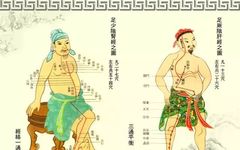The meridians are the body’s natural pharmacy, and to control this divine treasure, it is sufficient to understand the operational principles of the 12 meridians. This is the essence of the entire meridian theory in Traditional Chinese Medicine (TCM).
There are over 300 acupuncture points on the 12 meridians, and we do not need to memorize them all. Now, just follow me step by step, and it will be much easier.
12 Meridians
Hand Shaoyin Heart Meridian (Shou Shaoyin Xin Jing), Foot Shaoyin Kidney Meridian (Zu Shaoyin Shen Jing), Hand Jueyin Pericardium Meridian (Shou Jueyin Xin Bao Jing), Foot Jueyin Liver Meridian (Zu Jueyin Gan Jing), Hand Taiyin Lung Meridian (Shou Taiyin Fei Jing), Foot Taiyin Spleen Meridian (Zu Taiyin Pi Jing), Hand Taiyang Small Intestine Meridian (Shou Taiyang Xiao Chang Jing), Foot Taiyang Bladder Meridian (Zu Taiyang Pang Guang Jing), Hand Shaoyang Sanjiao Meridian (Shou Shaoyang San Jiao Jing), Foot Shaoyang Gallbladder Meridian (Zu Shaoyang Dan Jing), Hand Yangming Large Intestine Meridian (Shou Yangming Da Chang Jing), Foot Yangming Stomach Meridian (Zu Yangming Wei Jing).
Why are they named this way?

These 12 meridians are connected to the 12 organs of the human body, so these meridians are named after the connected organs. Among them, the Sanjiao refers to the entire chest and abdomen, and the Pericardium is a protective area for the heart, serving as a barrier for the heart, while the others are relatively easy to understand. Remembering the names of these 12 organs is very important; if you feel discomfort in any part of your body, check which meridian passes through that area, and you will find the corresponding one. From the arrangement of the 12 meridians, they are divided into two groups: one group is based on the hands and feet, and the other group is based on Yin and Yang. Follow the public account: Huangdi Neijing.
The division by hands and feet indicates that there are 6 meridians on the hands and arms, and 6 meridians on the feet and legs.
The division by Yin and Yang shows that there are 3 Yin meridians on the inner side of the arms and legs, and 3 Yang meridians on the outer side of the arms and legs.
What do Shaoyin, Jueyin, Taiyin, Taiyang, Shaoyang, and Yangming represent? They represent the heaviness and lightness of Yin energy, and the abundance and weakness of Yang energy.
Shaoyin has the heaviest Yin energy, so it is placed innermost on the inner side of the arms and legs.
Jueyin has lighter Yin energy than Shaoyin but heavier than Taiyin, so it is placed in the middle.
Taiyin has the lightest Yin energy, so it is placed on the outermost side.
Taiyang has the most abundant Yang energy, like the midday sun, so it is placed on the outermost side of the arms and legs.
Shaoyang has slightly weaker Yang energy than Taiyang, like the sun at 8 or 9 in the morning, so it is placed in the middle of the outer side.
Yangming has weaker Yang energy than Shaoyang, like the dawn light, so it is placed on the innermost side of the outer meridians.
Why did our ancestors subdivide Yin and Yang to such an extent? It is to remind you to pay attention to the balance of Yin and Yang when using the meridians. This balance of Yin and Yang includes the balance between meridians, the balance between the body and meridians, and the balance between meridians and nature. The balance between the body and meridians requires you to choose meridians based on the strength of your body. For example, if the body is weak, it is best to first choose Yang meridians for massage to replenish the righteous Qi; Yin meridians should be approached only after the righteous Qi is replenished; if the body is strong, both Yin and Yang meridians can be massaged.
The balance of Yin and Yang between meridians and nature is related to the temperature of the four seasons. In summer, Yang energy is most vigorous, so even those with weak bodies can unblock Yin meridians at this time. The theory of Yin and Yang balance can also be applied to the techniques used in massage; for Yin meridian massage, it is best to use tonifying techniques, while for Yang meridian massage, draining techniques can be used.
What are the tonifying and draining techniques in massage?
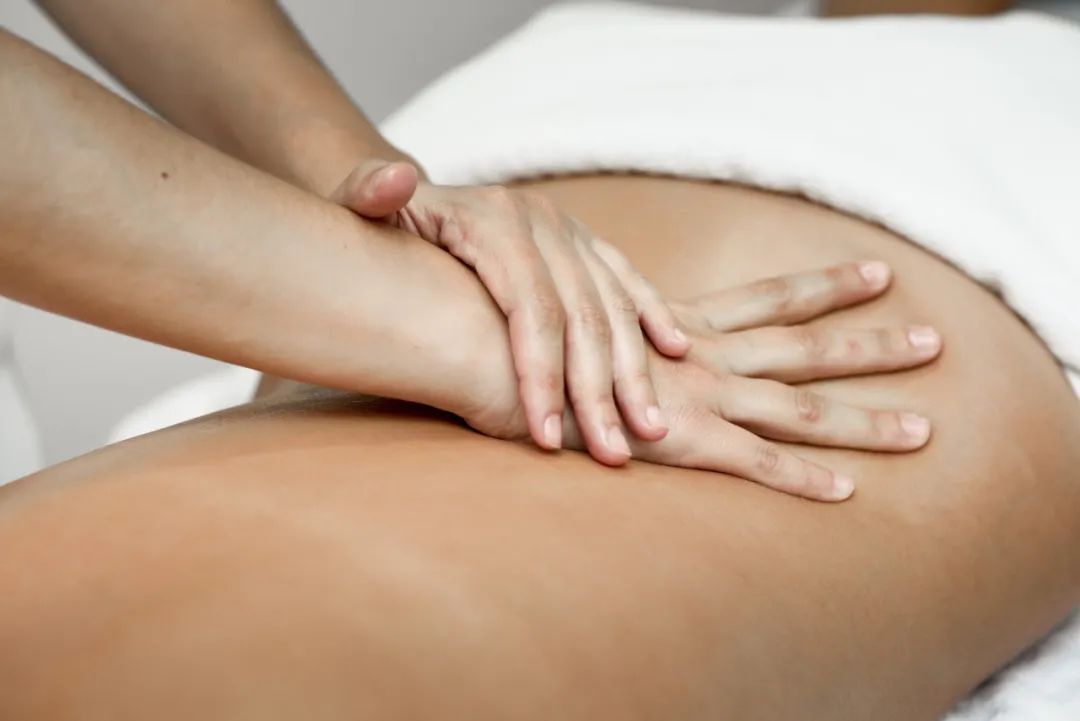
Generally speaking, massaging along the meridian is tonifying, while massaging against the meridian is draining.
Light pressure during massage is tonifying, while heavy pressure is draining.
Short duration of massage is tonifying, while long duration is draining.
Small area of massage is tonifying, while large area is draining.
Do you need to memorize over 300 acupuncture points?
In TCM, there is a saying during meridian massage called “Pain as the Point”, meaning that the painful area is the acupuncture point to massage.
For example, if you know you have a heart condition, you can slowly press along the corresponding Heart Meridian (Xin Jing) and Pericardium Meridian (Xin Bao Jing) to feel the sensations along the entire meridian. Follow the public account: Huangdi Neijing. If some areas feel sore, some feel sharp pain, some feel numbness, and some feel swollen, then focus your massage on the most painful area to relieve the condition, even using cupping, moxibustion, or tapping; the more pronounced the pain, the more you should persist in stimulating that area, and your body’s condition will improve quickly.
Some people may know they have heart issues, but when pressing on these two meridians, they do not feel significant pain. In this case, you should check both arms because the body’s meridians are symmetrical and consistent, but when there is illness, the responses of the left and right meridians may not be the same; the area with significant pain indicates where the illness is leaning, which also shows that the Qi and blood in that meridian are insufficient and the response is slow. In this case, treatment should focus on dietary therapy first to replenish Qi and blood, while slowly checking the meridian for any hard lumps or protrusions, and then focus on massaging that area. If you only memorize all the acupuncture points but ignore the most painful point, the treatment effect will not be good.
Let’s start with the most commonly used Foot Taiyang Bladder Meridian (hereinafter referred to as “Bladder Meridian”), as it has the most abundant Yang energy and the widest treatment range, making it the most commonly used meridian. The Bladder Meridian starts at the Jingming point at the corner of the eye, ascends over the forehead to the top of the head, travels down the back of the neck, the back, the outer side of the thigh, the back of the calf, and ends at the Zhiyin point on the outer side of the little toe. It has a total of 67 acupuncture points, making it the longest and most acupuncture points of all meridians in the body.
When the Bladder Meridian reaches the Zhiyin point on the little toe, its flow does not stop but continues through the little toe and ascends from the Yongquan point on the sole of the foot. At this point, the meridian has a new name – Foot Shaoyin Kidney Meridian (hereinafter referred to as “Kidney Meridian”).
The Kidney Meridian starts below the little toe, slants towards the sole of the foot, ascends along the inner edge of the sole and lower limb, passes through the abdomen, and reaches the chest, connecting with the next meridian, Hand Jueyin Pericardium Meridian (Shou Jueyin Xin Bao Jing).
From the flow direction of the Bladder Meridian to the Kidney Meridian, we can see:
1. The meridians are flowing and have a directional flow; the Bladder Meridian flows from top to bottom, while the Kidney Meridian flows from bottom to top.
2. The Bladder Meridian and Kidney Meridian are actually one connected meridian, only separated at the Zhiyin point on the outer side of the little toe; the Bladder Meridian runs on the outer side of the body, while the Kidney Meridian runs on the inner side. Because this Yang and Yin meridian is actually a connected meridian, stimulating the Bladder Meridian will also affect the Kidney Meridian; stimulating the Kidney Meridian will also affect the Bladder Meridian, which TCM refers to as “mutually exterior and interior,” and the organs connected by these two meridians – the kidneys and bladder – also mutually exterior and interior.
3. The Bladder Meridian is the meridian with the most abundant Yang energy among the Yang meridians, while the Kidney Meridian is the meridian with the heaviest Yin energy among the Yin meridians, which perfectly aligns with the characteristics of Yin and Yang balance in TCM.
4. The Bladder Meridian leads, and the Kidney Meridian follows; the Bladder Meridian is the source of the Kidney Meridian, so the methods of massage, acupuncture, and other unblocking techniques performed on the Bladder Meridian can promote the downward flow of the Bladder Meridian, which in turn promotes the Kidney Meridian and nourishes the kidneys.
When performing massage, acupuncture, etc., on the Kidney Meridian, if the Kidney Meridian runs faster but the Bladder Meridian cannot keep up, there will be gaps and interruptions. This is why massaging only the Kidney Meridian often leads to Qi deficiency.
Connected to the Bladder Meridian is the Hand Taiyang Small Intestine Meridian (hereinafter referred to as “Small Intestine Meridian”). It starts at the Shaoze point on the outer side of the little finger, ascends along the outer edge of the upper limb, passes over the shoulder, and divides into two branches: one goes from the neck to the cheek, to the ear, to the eye at the Jingming point, connecting with the Bladder Meridian, while the other enters the clavicle, into the thoracic cavity, and finally reaches the heart.
This meridian runs on the outer side of the arm, belongs to the Yang meridian, and is connected to the Bladder Meridian, forming a long and complete Taiyang meridian; the Small Intestine Meridian is in front, and the Bladder Meridian is behind. Follow the public account: Huangdi Neijing. The Small Intestine Meridian is the source of the Bladder Meridian; when the Bladder Meridian is uncomfortable, there may also be cervical spondylosis, low back pain, or leg pain. In addition to massaging the Bladder Meridian, massaging the Small Intestine Meridian is also effective and even better.
The Small Intestine Meridian is also connected to the Hand Shaoyin Heart Meridian (hereinafter referred to as “Heart Meridian”). The Heart Meridian starts at the heart and has several branches: one branch goes down to the Small Intestine, another goes up along the esophagus to the eyes, and another ascends in the lungs, exits at the armpit, and travels along the back edge of the upper arm to the inner wrist, reaching the Shaochong point on the inner side of the little finger, then goes towards the outer side of the little finger to the Shaoze point of the Small Intestine Meridian, and continues upward.
This is a meridian that transforms from Yin to Yang, a long and connected meridian that is mutually exterior and interior. Therefore, massaging the Heart Meridian can not only treat discomfort related to the Heart Meridian, such as the heart, Small Intestine, lungs, esophagus, and eyes, but also promote and nourish the Small Intestine Meridian. Massaging it can treat diseases of the cervical spine, lumbar spine, and legs, as well as kidney diseases.
Whenever there are issues with the neck, shoulders, or waist, you can check the Small Intestine Meridian on the outer side of the arm for significant pain points, and then check the Heart Meridian, which is mutually exterior and interior, for any blockages or pain. At this time, you should unblock the Heart Meridian from the source by gently rubbing from the armpit down to the little finger, and then rubbing from the outer side of the little finger up to the outer side of the arm, focusing on areas with pain. This way, you can treat all the issues related to the Heart Meridian, Small Intestine Meridian, Bladder Meridian, and Kidney Meridian.
These four meridians form two long connected groups that are mutually exterior and interior, starting from the heart, circling around the limbs, and then pushing the Kidney Meridian towards the abdomen and chest.
Which meridian connects with the Heart Meridian in the chest?
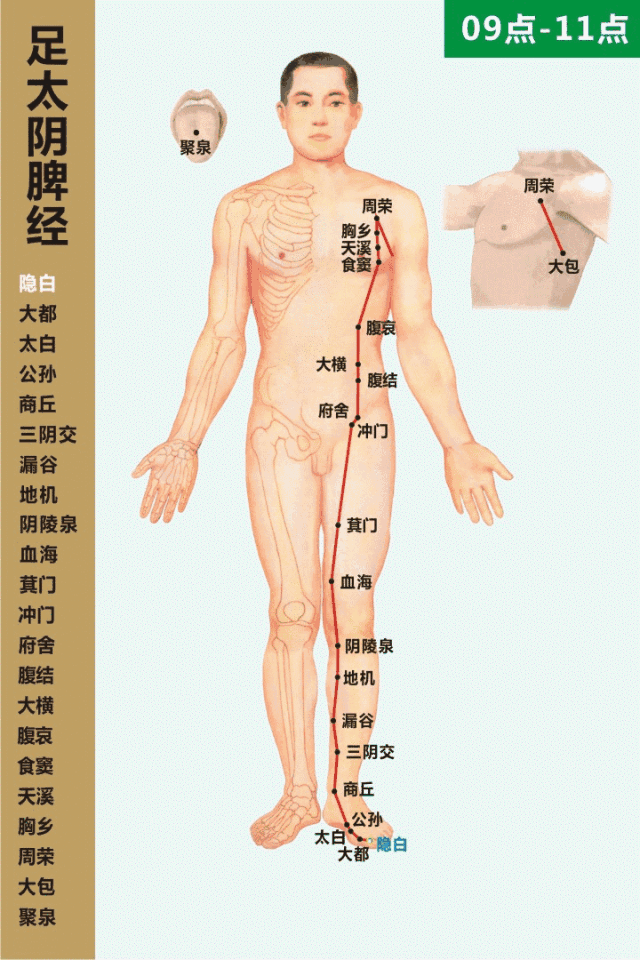
This is the Foot Taiyin Spleen Meridian (hereinafter referred to as “Spleen Meridian”). At this point, some may ask, one is Shaoyin, and the other is Taiyin; it seems that balance cannot be achieved in Yin and Yang. Why is that? We will discuss this later. Follow the public account: Huangdi Neijing.
After the Kidney Meridian connected to the Bladder Meridian reaches the chest, it connects with the Hand Jueyin Pericardium Meridian (hereinafter referred to as “Pericardium Meridian”), which is a connection between Yin meridians. However, one is called Shaoyin, and the other is called Jueyin, with different names and different levels of Yin energy. When the meridian reaches here, it seems that the function and relationship are different from when it was circling around the limbs. Why? Because when the meridian reaches the Kidney Meridian, it is already very weak, so generally, we do not massage the Kidney Meridian; excessive massage will drain Qi. At this point, the meridians entering the abdomen and chest need to rest and replenish energy before continuing the next round of circulation in the limbs. Therefore, the Dantian point, which has the strongest Qi replenishing effect, is located in the abdomen, and the meridians that pass through the abdomen are the already fatigued Kidney Meridian, Liver Meridian, and Spleen Meridian.
There is also a meridian that passes through the abdomen, which is the Foot Yangming Stomach Meridian (hereinafter referred to as “Stomach Meridian”). It also passes through the abdomen, but its direction of flow is different from that of the Kidney Meridian, Liver Meridian, and Spleen Meridian, as it runs from the head through the chest and abdomen to the feet. The Stomach Meridian also needs to replenish energy here to enhance its downward force and strengthen the digestive capacity of the Spleen and Stomach.
The next round of circulation in the limbs starts from the Kidney Meridian passing to the Pericardium Meridian, which runs in the middle of the inner side of the limbs. Therefore, it connects with the Hand Shaoyang Sanjiao Meridian (hereinafter referred to as “Sanjiao Meridian”), which runs in the middle of the outer side of the arms, and connects with the Foot Shaoyang Gallbladder Meridian (hereinafter referred to as “Gallbladder Meridian”), which runs in the middle of the outer side of the legs, and the Gallbladder Meridian connects with the Foot Jueyin Liver Meridian (hereinafter referred to as “Liver Meridian”), forming another completely connected and mutually exterior and interior group of meridians, ultimately pushing the Liver Meridian towards the lower abdomen and chest to rest and replenish energy before continuing on a different path.
The last round of circulation involves the four meridians, with the Liver Meridian in the chest, passing to the Hand Taiyin Lung Meridian (hereinafter referred to as “Lung Meridian”). The specific order of circulation is as follows: Lung Meridian → Large Intestine Meridian → Stomach Meridian → Spleen Meridian.
All diseases in the human body can be found along the meridians.
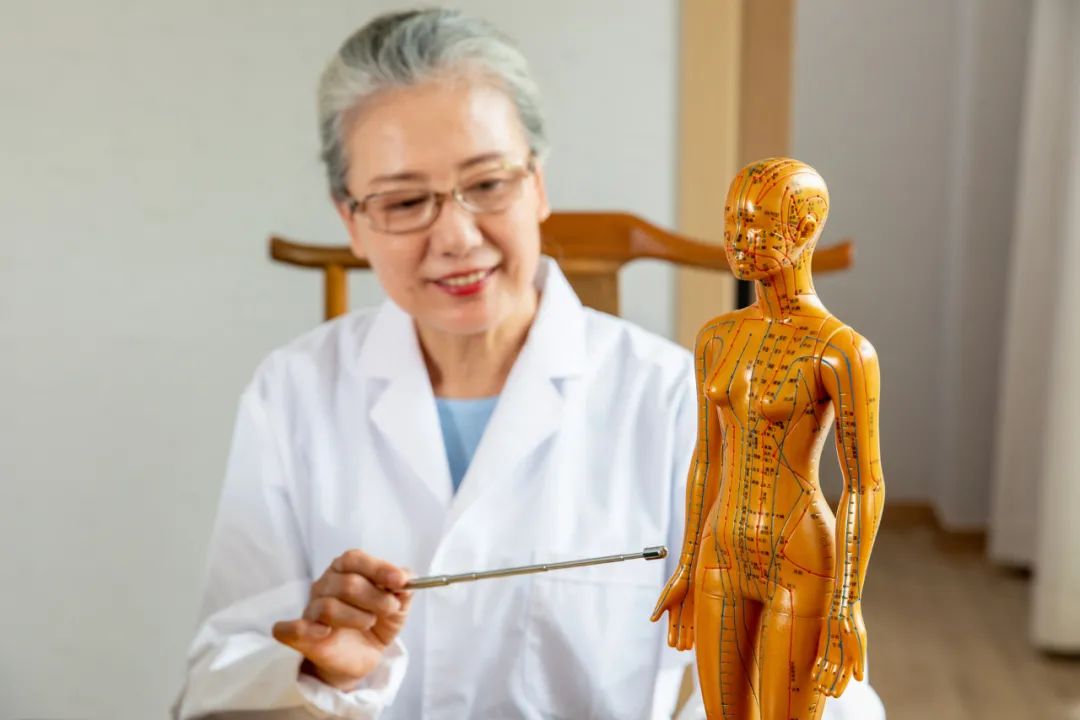
From the above discussion, you will understand that these 12 meridians are divided into 3 major groups. These 3 major groups form a large circle around the limbs and then return to the abdomen and chest, making it easier to remember. You only need to memorize the 4 meridians in each group and remember the names of the organs connected to these 4 meridians. If one of these 4 organs becomes ill, you can start looking for pain points from the source of these 4 meridians, which is the meridian running from the chest to the inner side of the arms, and slowly massage or tap or scrape to gradually smooth it out. This way, not only will the treatment be effective, but it will also prevent future complications and recurrences.
The circulation of the 3 major meridian groups in the body is already clear, but which group comes first and which comes last?
TCM divides them as follows:
Group 1: Running on the outer side, is Lung Meridian → Large Intestine Meridian → Stomach Meridian → Spleen Meridian.
Group 2: Running on the inner side, is Heart Meridian → Small Intestine Meridian → Bladder Meridian → Kidney Meridian.
Group 3: Running in the middle, is Pericardium Meridian → Sanjiao Meridian → Gallbladder Meridian → Liver Meridian.
Additionally, when using meridians to treat diseases, it is important to choose the right time. TCM believes that humans and the universe are closely related as a unified whole, and the human body is actually a microcosm of the universe. All changes in nature (such as the alternation of day and night) are closely related to human life activities. Follow the public account: Huangdi Neijing. In ancient China, people divided the 24 hours of a day into 12 time periods, and TCM corresponds each time period to one of the 12 meridians, as shown in the table below.
Group 1:
| Time Period | Time | Meridian |
| Yin Hour | 3:00–5:00 | Lung Meridian |
| Chen Hour | 5:00–7:00 | Large Intestine Meridian |
| Yin Hour | 7:00–9:00 | Stomach Meridian |
| Si Hour | 9:00–11:00 | Spleen Meridian |
Group 2:
| Time Period | Time | Meridian |
| Wu Hour | 11:00–13:00 | Heart Meridian |
| Wei Hour | 13:00–15:00 | Small Intestine Meridian |
| Shen Hour | 15:00–17:00 | Bladder Meridian |
| You Hour | 17:00–19:00 | Kidney Meridian |
Group 3:
| Time Period | Time | Meridian |
| Xu Hour | 19:00–21:00 | Pericardium Meridian |
| Hai Hour | 21:00–23:00 | Sanjiao Meridian |
| Zi Hour | 23:00–1:00 | Gallbladder Meridian |
| Chou Hour | 1:00–3:00 | Liver Meridian |
The Significance of Corresponding the 12 Time Periods with the 12 Meridians
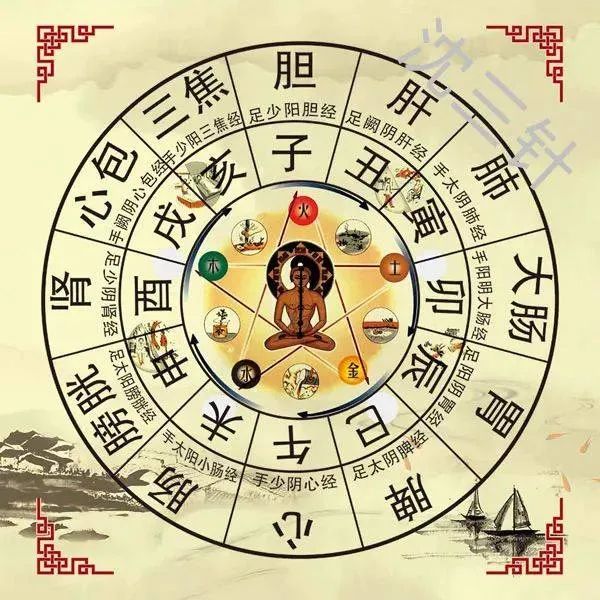
“Qi and blood arrive at the right time to be abundant; Qi and blood leave when overdue to be deficient. Drain when it is abundant, tonify as it departs; when it is timely, it rises; when overdue, it closes.” It turns out that these 12 meridians follow a temporal order, just like tides; wherever they flow, that meridian experiences a “high tide,” and at that time, the Qi and blood in that meridian are most vigorous. Therefore, many practitioners prefer to unblock the meridian with the most vigorous Qi and blood at specific times or take herbs to regulate the corresponding organ at that time, achieving twice the result with half the effort. This is the relationship between meridians, organs, and time.
We have divided these 12 meridians into 3 major groups, making it simple to prevent and treat diseases based on time.
For discomfort in the Lung Meridian, Large Intestine Meridian, Stomach Meridian, and Spleen Meridian, it is best to massage and treat in the morning or forenoon.
For discomfort in the Heart Meridian, Small Intestine Meridian, Bladder Meridian, and Kidney Meridian, it is best to massage and treat at noon or in the afternoon.
For discomfort in the Pericardium Meridian, Sanjiao Meridian, Gallbladder Meridian, and Liver Meridian, it is best to massage and treat in the evening.
For example, for someone with stomach issues, they can find pain points on the Lung Meridian and Large Intestine Meridian on the outer side of the arm in the morning or forenoon, and then find pain points on the Stomach Meridian and Spleen Meridian on the legs, massaging them in order.
For those with neck and shoulder pain or back issues, they can find pain points on the Heart Meridian and Small Intestine Meridian on the inner side of the arm at noon or in the afternoon, and then massage the painful neck and back areas.
For those with liver issues, it is best to find pain points on the Pericardium Meridian and Sanjiao Meridian in the middle of the arm in the evening, massage them, and then find painful or blocked areas on the Gallbladder Meridian on the outer side of the legs and the Liver Meridian on the inner side for massage.
For those with good health and sufficient Qi and blood, they can use slightly heavier techniques when unblocking meridians, applying tapping or scraping methods on painful or blocked areas. For those with weak bodies and deficient Qi and blood, they should not rush; the pressure during massage should be lighter, and the selected acupuncture points and pain points should be fewer, preferably focusing on the first two meridians in each group (the arm meridians) and avoiding the last meridians (Kidney Meridian, Liver Meridian, Spleen Meridian) as much as possible.
Understanding these principles allows you to unblock the congested meridians based on your physical condition, different seasons, and times, while supplementing Qi and blood and dispelling cold and dampness. If used properly, everyone can skillfully utilize the miraculous meridians to safeguard their health and that of their loved ones.
Finally, I would like to add that the previously mentioned “Dantian” is like a nuclear reactor within the body, with immense energy. Various martial arts in China have mentioned “Dantian.” Follow the public account: Huangdi Neijing. When cultivated to a certain level, a warm airflow will form in the Dantian area, which can be tangible when gathered and intangible when dispersed. It will circulate along the Ren and Du meridians, which run along the midline of the body, with the Ren Meridian in front and the Du Meridian behind.
When the Qi flows around the Ren and Du meridians, it is called “Small Circulation.” The Small Circulation runs along the Ren Meridian on the front of the body, which has a comprehensive effect on all Yin meridians. The Dantian that the Ren Meridian passes through is the place where men store essence and women maintain the womb, also known as the “source of life.” The “Du” in the Du Meridian has a “supervisory” function, and since the Du Meridian runs through the spinal cord, it is directly connected to the spinal cord and brain, thus having a significant relationship with a person’s spirit, will, and thoughts. The Ren and Du meridians are also connected to all organs in the body; when the true Qi is sufficient, these five organs and six bowels can be directly nourished.
The functions of the Ren and Du meridians correspond to what TCM refers to as the function of the “Kidneys.” TCM believes that the kidneys are the “foundation of pre-natal essence” and that the formation of the fetus begins in the kidneys, hence the saying, “Before this body exists, there are two kidneys; therefore, the kidneys are the root of the organs and the source of the twelve meridians.” The functions of the kidneys include: storing essence, governing reproduction, controlling the Mingmen fire, warming and illuminating the whole body, governing bones, marrow, blood production, water, and receiving Qi.
Throughout history, many internal cultivation methods have been able to generate and nourish Qi, which essentially involves unblocking the Small Circulation and the larger circulation centered around the 12 meridians. Therefore, some high monks meditate in silence, abstaining from food and drink, using the internal cultivation they have developed to nourish their bodies, promote the flow of meridians, and ensure the longevity of life. Tai Chi, Baguazhang, and Wuqinxi are also practices that use gentle Qigong movements to unblock meridians.
If you can cultivate internal energy or persist in meditating every night, directly allowing the Qi in your Dantian to fill and promote the flow of all meridians, that would be ideal, but it is difficult for ordinary people to achieve. However, we can supplement Qi and blood through dietary therapy to replenish kidney Qi, and over time, we can achieve the same effect.
Palpation of the Meridians
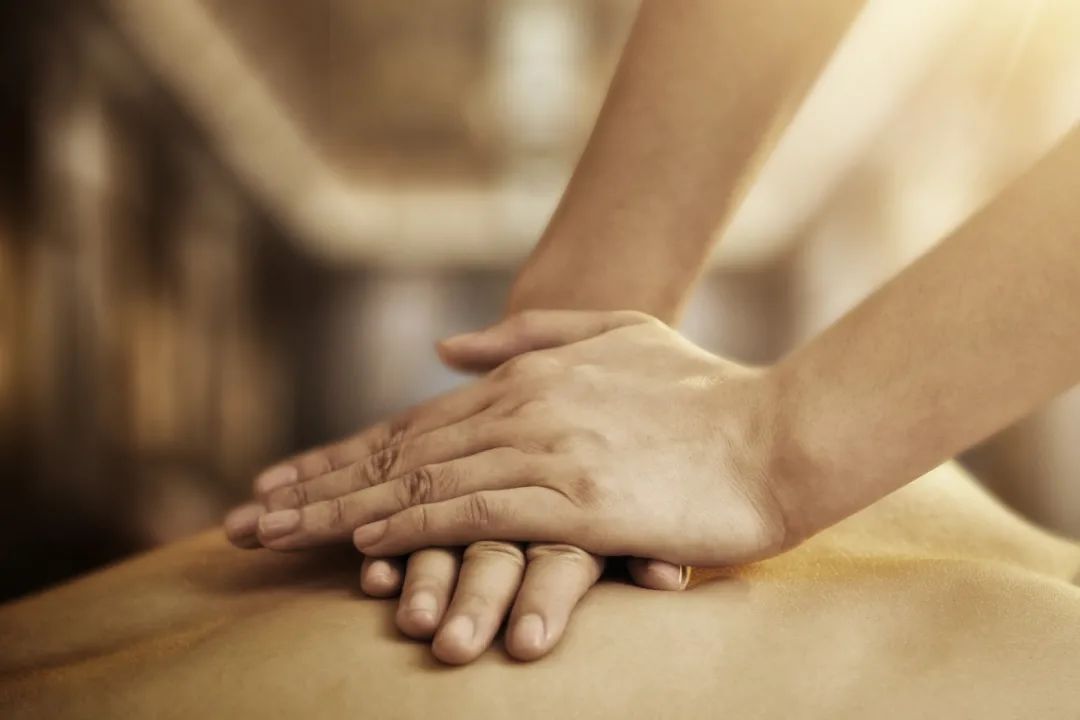
The sensation of the finger pads can detect abnormalities in the meridians and acupuncture points. This method is simple, easy to perform, and accurate (it is one of the essential diagnostic methods in acupuncture clinics).
Method: Touch along the meridian; if the surface shows heat, swelling, strong elasticity, and significant tenderness, it indicates that the meridian Qi is full; if the surface temperature is low, lacks elasticity, feels sore and numb without pain, and sinks down, it indicates that the meridian Qi is deficient.
During palpation, if there are hard lumps, tenderness, sensitivity, or quick sensations, this point is a disease point. Strong tenderness often indicates a full condition; quick sensations often indicate a deficient condition. Disease points help clarify the diagnosis, and needling or moxibustion at these points often yields good results.
Palpation order: Back Shu points, Front Mu points, Local points, Yuan points, Luo points, Special examination points, Sensitive points, and Sensitive areas, etc. Any suspicious meridian should be palpated in detail.
Key Points for Palpation of the Twelve Meridians
Lung Meridian: Lung Shu, Zhongfu, Kongzui, Gaohuang, Chize.
When the Lung Meridian has full heat, there is tenderness 0.5 inches beside the thoracic vertebrae 1-3, and tenderness at Shanzhong and Daju. When the Qi of the Lung Meridian is not smooth, there is tenderness at the Xuan Zhong point. When the Lung Meridian is deficient and cold: Fengmen and Dazhu have a feeling of heaviness. For hemoptysis or hematochezia: Kongzui has tenderness, or there is a feeling of heaviness when pressed. When the meridian Qi is deficient, the Gaohuang point appears swollen or elastic, and the skin temperature is low.
Large Intestine Meridian: Large Intestine Shu, Tianjiao, Wenliu, Quchi, Hegu.
When the meridian Qi is full or there is an excretion obstruction, there is tenderness at Quchi, Lung Shu, Tian Shu, and Qizhu. When the meridian Qi is stagnant, there is tenderness at Daju. In cases of enteritis, Shousanli, Shangju, and Tian Shu show significant tenderness, and the skin temperature is higher than adjacent points. In chronic enteritis, the skin temperature is lower, and there is a quick sensation.
Stomach Meridian: Stomach Shu, Zhongyuan, Liangqiu, Zusanli, Fenglong.
When the Stomach Meridian has full heat: Zhongyuan and Liangqiu have tenderness. When there is excessive stomach acid: Juque and Burong show tenderness.
When the Stomach Meridian is deficient and cold: pressing Zhongwan and Zusanli feels comfortable. For gastric ulcers: Stomach Shu and its outer side have sensitive points, and when pressing the buttocks, tenderness radiates below the knee.
Severe stomach pain: Tianzong has significant tenderness, and pressing it can relieve pain.
Spleen Meridian: Spleen Shu, Zhangmen, Diji, Dabao, Spleen Shu.
When there is indigestion or abnormal transportation, Spleen Shu, Zhangmen, and Dabao all have tenderness. When blood circulation is unbalanced, Spleen Shu shows tightness or tenderness. For Spleen heat or Qi stagnation, Diji has significant tenderness. For Spleen deficiency causing bloating, pressing Spleen Shu shows heaviness or the skin temperature is low. Follow the public account: Huangdi Neijing.
Heart Meridian: Heart Shu, Juque, Yinxin, Shaohai.
When the Heart Meridian has excessive fire: the inner side of Heart Shu has tenderness. For heart valve diseases: Juque is swollen, and there are sensitive points from Heart Shu to Gaohuang. When the meridian Qi is deficient or the function is low: Sanyinjiao, Shuifen, and Kidney Shu all have tenderness.
Small Intestine Meridian: Small Intestine Shu, Guanyuan, Yanglao, Xiaohai, Xiaojuxu.
For Small Intestine Meridian diseases: Guanyuan and Yanglao show reactions. When invaded by wind and cold, Tianzong, Fengmen, and Xiaohai have tenderness. When Small Intestine Meridian diseases transfer to the Heart Meridian, pressing Guanyuan is effective. For moxibustion at Guanyuan to treat arrhythmia. When Qi of the Small Intestine Meridian is obstructed, Xiaojuxu shows tenderness, and needling is effective. Pain in the lumbar region at the Small Intestine Shu area shows significant tenderness, and needling is effective.
Bladder Meridian: Bladder Shu, Zhongji, Jinmen, Weizhong, Kunlun, Tianzhu, Bayao.
When the meridian Qi is full of heat: Weizhong has high skin temperature, and the collaterals are full. When damp heat descends and the meridian Qi is obstructed, Zhongji, Jinmen, and Bladder Shu have tenderness. When invaded by wind and cold, Tianzhu, Bayao, and Chengshan show tenderness. When the meridian Qi is deficient, pressing Zhongji and Bladder Shu gives a quick sensation.
Kidney Meridian: Kidney Shu, Jingmen, Shuiquan, Shuifen, Huangshu.
When there are diseases in the Kidney Meridian: Shuiquan, Shuifen, and Huangshu all show tenderness. When the kidneys are diseased: Kidney Shu and Jingmen have tenderness. When the kidney excretion function is impaired, Zhuyin shows a positive response (hard lumps, tenderness). Therefore, moxibustion at Zhuyin has a detoxifying effect. When there are urinary system issues, Bayao shows tenderness.
Pericardium Meridian: Jueyin Shu, Shanzhong, Xiemen, Daling.
When emotions are unsettled, and laughter and tears are unpredictable: Shanzhong and Xiemen show significant tenderness. For women with menstrual irregularities, dysmenorrhea, or lower abdominal blood stasis, there may be tightness or tenderness at Xiemen, which can be needled to regulate menstruation and relieve pain. For palpitations, pressing Jueyin Shu and Shanzhong can relieve symptoms, and moxibustion is also effective.
Sanjiao Meridian: Sanjiao Shu, Shimen, Weiyang, Huizong.
When the meridian Qi is obstructed, Huizong, Weiyang, and Shimen all show tenderness. When the meridian Qi is full of heat, the Sanjiao Shu area is tight, and Huizong shows strong tenderness. For urinary retention, which belongs to the Sanjiao Meridian Qi not being expressed, Shimen shows fullness.
Gallbladder Meridian: Gallbladder Shu, Riyue, Tianzong, Jing, Yanglingquan, Waiqiu.
When there is cholecystitis, Riyue, Jingmen, and Tianzong show tenderness. When the Gallbladder Meridian has full heat: Waiqiu has high skin temperature. When the meridian Qi is deficient: pressing Gallbladder Shu and Riyue feels comfortable.
Liver Meridian: Liver Shu, Qimen, Zhongdu, Ququan.
When the meridian Qi is stagnant (insomnia, irritability, hypertension): Liver Shu often shows swelling and tenderness, and Zhongdu shows strong tenderness. For hepatitis (meridian Qi full of heat), there may be a sensitive area from 2 inches above the inner ankle to Zhongdu, and Yanglingquan and Waiqiu may also show tenderness. For sexual dysfunction: pressing Ququan may cause pain or heaviness.
By using the above methods to identify the disease meridian and points, combined with the four examinations and eight principles, we can determine the cause, location, and nature of the disease, and propose effective treatment plans.
You can remember the distribution of meridians without rote memorization:
Order of Meridian Flow:
Hand Taiyin Lung Meridian → Hand Yangming Large Intestine Meridian Taiyin (most abundant Yin energy) → Yangming (most abundant Yang energy)
Foot Yangming Stomach Meridian → Foot Taiyin Spleen Meridian Yangming (most abundant Yang energy) → Taiyin (most abundant Yin energy)
Hand Shaoyin Heart Meridian → Hand Taiyang Small Intestine Meridian Shaoyin (second most abundant Yin energy) → Taiyang (second most abundant Yang energy)
Foot Taiyang Bladder Meridian → Foot Shaoyin Kidney Meridian Taiyang (second most abundant Yang energy) → Shaoyin (second most abundant Yin energy)
Hand Jueyin Pericardium Meridian → Hand Shaoyang Sanjiao Meridian Jueyin (weakest Yin energy) → Shaoyang (weakest Yang energy)
Foot Shaoyang Gallbladder Meridian → Foot Jueyin Liver Meridian Shaoyang (weakest Yang energy) → Jueyin (weakest Yin energy)
Yin and Yang represent the Yin and Yang attributes of the meridians and the abundance of Yin and Yang Qi. One Yin and one Yang evolve into three Yin and three Yang.
From abundant to deficient, they are:
Taiyin, Shaoyin, Jueyin — Yangming, Taiyang, Shaoyang
Taiyin — Yangming
Shaoyin — Taiyang
Jueyin — Shaoyang
Yang meridians connect with Yang meridians (in the head and face), Yangming — Yangming, Taiyang — Taiyang, Shaoyang — Shaoyang
Yin meridians connect with the next Yin meridian (in the chest and abdomen), Taiyin — Shaoyin, Shaoyin — Jueyin, Jueyin — Taiyin
Yin meridians connect with the same abundant Yang meridian (exterior meridian), Taiyin — Yangming, Shaoyin — Taiyang, Jueyin — Shaoyang
Yang meridians connect with the same abundant Yin meridian (exterior meridian), Yangming — Taiyin, Taiyang — Shaoyin, Shaoyang — Jueyin
Hand Yin meridians flow from the chest (abdomen) to the hand — Hand Yang meridians flow from the hand to the head — Foot Yang meridians flow from the head to the foot — Foot Yin meridians flow from the foot to the chest (abdomen)
Yang meridians run on the outer side of the body, while Yin meridians run on the inner side (outer is Yang, inner is Yin) — like sunlight reaching and not reaching
Yang meridians run on the back of the body, while Yin meridians run on the abdomen (back is Yang, abdomen is Yin) — facing the yellow earth, back to the sky
Taiyin and Yangming (most abundant) are in front; Shaoyin and Taiyang (second most abundant) are behind; Jueyin and Shaoyang (weakest) are in the middle.
Note:At 8 inches above the inner ankle, the Foot Jueyin Meridian and Foot Taiyin Meridian intersect; the Jueyin Meridian runs before the Taiyin Meridian, the Taiyin Meridian runs in the middle, and the Taiyang Meridian is still last.
Continuing this logic leads to:
Hand Taiyin — Hand Yangming — Foot Yangming — Foot Taiyin — (Hand Shaoyin)
Hand Shaoyin — Hand Taiyang — Foot Taiyang — Foot Shaoyin — (Hand Jueyin)
Hand Jueyin — Hand Shaoyang — Foot Shaoyang — Foot Jueyin — (Hand Taiyin)
Finally, remember:
Mnemonic: Lung, Large Intestine, Stomach, Spleen, Heart, Small Intestine, Bladder, Kidney, Pericardium, Sanjiao, Gallbladder, Liver. (Lung, Large Intestine, Stomach, Spleen, Heart, Small Intestine, Bladder, Kidney, Pericardium, Sanjiao, Gallbladder, Liver)
Corresponding:
Hand Taiyin (Lung) — Hand Yangming (Large Intestine) — Foot Yangming (Stomach) — Foot Taiyin (Spleen) — (Hand Shaoyin)
Hand Shaoyin (Heart) — Hand Taiyang (Small Intestine) — Foot Taiyang (Bladder) — Foot Shaoyin (Kidney) — (Hand Jueyin)
Hand Jueyin (Pericardium) — Hand Shaoyang (Sanjiao) — Foot Shaoyang (Gallbladder) — Foot Jueyin (Liver) — (Hand Taiyin)
Acupuncture Point Mnemonics
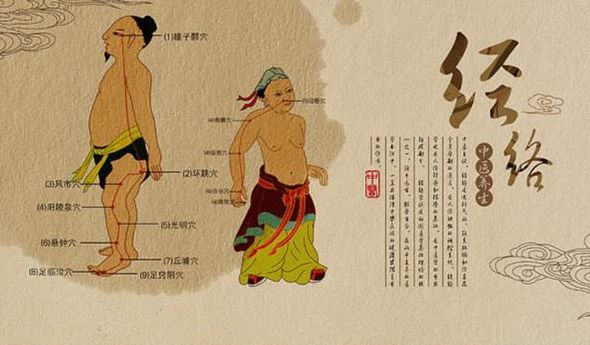
1. Fainting — Water Ditch, Zhongchong, Yongquan, Zusanli.
Mnemonic: To wake up from fainting, you need to be in the ditch by the spring in the mountains.
2. Collapse — Sujiao, Water Ditch, Neiguan.
Mnemonic: For collapse, you need to quickly (Su) close the water ditch.
3. Convulsions — Baihui, Yintang, Renzhong, Hegu, Taichong.
Mnemonic: In the hall (Renzhong), Baihui’s fragrance causes convulsions.
4. Stroke Closed Syndrome — Twelve Well Points, Water Ditch, Taichong, Fenglong.
Mnemonic: Stroke is caused by the twelve ditches’ foul smell being too strong, causing a loud (Feng) sound and falling.
5. Stroke Collapse Syndrome — Guanyuan, Shenque (Ginger Moxibustion). Sweating with Yinxi, Fuliu, and urinary incontinence with Sanyinjiao.
Mnemonic: Stroke collapse syndrome will cause the spirit to leave the body.
6. Dysmenorrhea — (Full Condition) Zhongji, Ciliao, Diji. (Deficient Condition) Qihai, Guanyuan, Zusanli, Sanyinjiao.
Mnemonic: Full pain is due to being in the middle (Zhongji) and eating (Ciliao) low-grade (Diji) food. Deficient pain is due to the three Yin days being in the mountains for too long without closing the circle (Guanyuan).Follow the public account: Huangdi Neijing.
7. Visceral Cramping Pain
(1) Angina Pectoris — Heart Shu, Jueyin Shu, Neiguan, Shanzhong.
Mnemonic: For angina pectoris, rest in the inner hall; the calmer the heart, the better you feel.
(2) Acute Cholecystitis, Gallstones — Gallbladder Shu, Liver Shu, Riyue, Qimen, Yanglingquan, Gallbladder Point.
Mnemonic: Gallbladder diseases are treated by the liver and gallbladder; Riyue is continuous, and Qimen opens up.
(3) Ascaris Lumbricoides in the Bile Duct — Yingxiang through Sibai, Jiumei through Riyue, Gallbladder Point, Zhongwan, Yanglingquan.
Mnemonic: The nine tails steal the sun and moon; do you want to (Yingxiang) steal four hundred? Passing by Yanglingquan, gallbladder fear early morning and evening.
(4) Renal Colic — Kidney Shu, Sanjiao Shu, Guanyuan, Yinlingquan, Sanyinjiao.
Mnemonic: Renal colic can be cured by the Yanglingquan in the Grand View Garden; three calls and three responses will heal the kidney.
8. Toothache — Hegu, Xiaguan, Jiachuan.
Mnemonic: Why (Hegu) go down? Toothache.
9. High Fever — Dazhui, Twelve Well Points, Shixuan, Quchi, Hegu.
Mnemonic: Why do you take twelve pounds of big nails to the pool? To release the heat.
10. Vascular Headache
(1) External Headache — Baihui, Taiyang, Fengchi, Hegu.
Mnemonic: Why (Hegu) does the sun and wind always meet (Baihui)? Let me have a headache!
(2) Internal Injury Headache
A. Liver Yang Headache — Baihui, Fengchi, Taichong, Taixi.
Mnemonic: The kindness (Chi) and joy (Xi) meet at Taizong (Taichong), and great anger causes the liver yang to rise.
B. Kidney Deficiency Headache — Baihui, Kidney Shu, Spleen Shu, Zusanli.
Mnemonic: Walking three miles to meet a friend, the friend says: I have kidney and spleen deficiency, causing headache.
C. Blood Deficiency Headache — Baihui, Heart Shu, Spleen Shu, Zusanli.
Mnemonic: Walking three miles to meet a friend, the friend says: I have heart and spleen deficiency, causing headache.
D. Phlegm-Damp Headache — Touwei, Taiyang, Fenglong, Yinlingquan.
Phlegm-damp headache can cause fullness in the head and temples, possibly due to excessive dampness at Yinlingquan.
E. Blood Stasis Headache — Ashi point, Hegu, Xuehai, Sanyinjiao.
Why does blood stasis cause headache? It is due to the intersection of three Yin energies at Xuehai!
11. Acute Lumbar Strain — Kidney Shu, Yaoyan, Weizhong.
For lumbar strain, massage the kidney area and listen to soothing music.
12. Vomiting — Zhongwan, Neiguan, Zusanli.
In the ditch, walking three miles, Zhongwan feels uncomfortable and vomits.
Please share this article with everyone.

